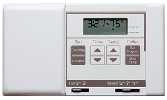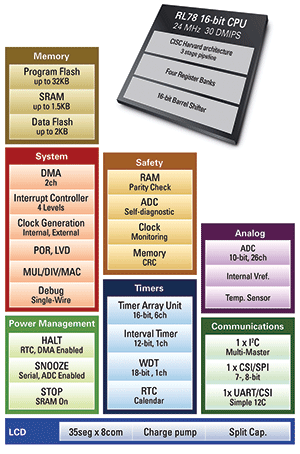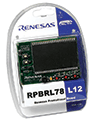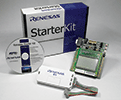

For battery powered applications such as electric toothbrushes, razors and personal medical equipment such as blood pressure monitors that traditionally used mechanical switches, logic circuits or small, simple-function MCUs and discrete LCD drive circuits, there is increasing consumer demand for additional functionality combined with the necessity of longer product operation between battery charges.
These next-generation, miniature battery powered portable devices may have a single or multiple LCD displays, require timer or motor control functionality or may even require wireless functionality.

Combining this demand for such additional features whilst at the same time increasing battery life is driving growth for low-pin-count, low-cost and ultra low-power MCUs that offer a platform approach for multiple features. Some vendors offer low pin count MCUs, some offer low power features to reduce current consumption from the MCU core or peripherals, but this is not sufficient to offer lower total system power whilst driving a Human Machine Interface (HMI) or the integrated LCD.
The LCD display used for a product’s HMI is usually a basic alphanumeric pixel panel and may include some timer display or display some simple visual operation relevant to the application. The new Renesas RL78/L1x (LCD) series offers multiple low-power modes combines with a unique method that allows up to 50% reduction in MCU energy consumption whilst driving an LCD display compared to legacy solutions.

The alphanumeric displays used in these miniature applications for the HMI are usually physically small with low pin count. Each of the relevant pins requires drive to each of the individual display segments. The drive will be AC as DC drive causes electromechanical reactions that can reduce display life.
This AC drive is effectively time division multiplex (TDM)-driven but the number of time divisions needs to be twice the number of common planes of the display to ensure the voltage at all segment locations is reversed periodically to avoid any DC voltage. Generating these divisions as waveforms is handled by the LCD controller. However, it is necessary to generate the required number of intermediate bias voltages and there are several means for achieving this.
The RL78/L1x family features split capacitance LCD drive. This capacitor split method of generating the LCD bias voltages can halve the power consumption. It is similar in principle to traditional resistive splitting, where the required bias voltages are defined by the values of external capacitors. The capacitor split method ensures there is no wasted current flowing continually through the resistive split bias chain or consumed by a capacitive charge pump circuit.

In the case of the RL78/L12, the capacitor split method enables an ultra low-power mode (sub halt) that consumes a mere 0,62 μA at 3 V with the LCD active and RTC running. This is less than half of the typical 1,5 μA current taken by traditional voltage boost or resistive split methods. Even these figures disguise the true power saving – the capacitive split circuitry only draws 0,12 μA, with the other 0,5 μA being consumed by the real-time clock.
The traditional method for driving the display i.e., doing this externally with a simple resistive divider chain between supply and ground, can also be achieved with the RL78/L1x family. The values of the resistors will be determined by the required bias voltage levels, but will need to be low enough to not be affected by the capacitive load presented by the LCD panel; it may even be necessary to add smoothing capacitors between the bias points and ground to stabilise the levels.
Alternatively, the voltage boost method can also be handled by the RL78/L1x using an internal circuit. This typically uses a reference voltage equal to the lowest bias level and then multiplies this up by as many times as necessary to provide the higher bias levels. One advantage of this approach is that the bias levels can be independent of the controller’s supply voltage.
Two starter kits are available for the new RL78/L12 family: the low-cost Renesas Promotion Board (RPB) for simple evaluation and the Renesas Starter Kit (RSK) for full evaluation and development.
For more information contact Marinus Rudman, Hi-Q Electronics, +27 (0)21 595 1307, [email protected], www.hi-q.co.za.
| Tel: | +27 21 595 1307 |
| Email: | [email protected] |
| www: | www.hi-q.co.za |
| Articles: | More information and articles about Hi-Q Electronics |

© Technews Publishing (Pty) Ltd | All Rights Reserved